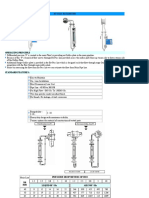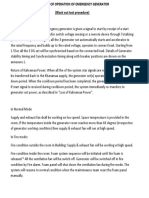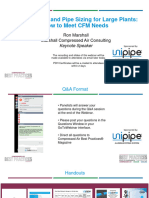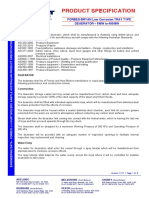Process GCs/Process Analyzers (Total VOCs)
Uploaded by
Jennifer MaclachlanProcess GCs/Process Analyzers (Total VOCs)
Uploaded by
Jennifer MaclachlanProcess GCs/Process Analyzers (total)
For Process and Environmental Monitoring in Chemical, Petrochemical & Manufacturing Plants
FENCELINE, PROCESS, STACKS, AREA MONITORING, CARBON BEDS
Model 301C GC Series
Model 200-B Series
19 Rack Mount
19 Rack Mount
Wall Mount
Wall Mount
301C- GC - BTX, ETO, non-methane HC, H2S, Total S compounds, Natural Gas, Odorants,.. 200 - Continuous Analyzers for total VOCs, Total HCs, Total S compounds, H2, (ppm to %)
MODEL 200/301C PRODUCT LINE
Hydroarbons, VOCs, benzene, 1,3 BD, VC, ETO, H2, CO, CO2, fixed gases, methane, ethylene, natural gas, O2, H2S, Dimethyl sulfate, DMS, SO2, PH3, ASH3, amines, NH3, Methylene chloride, nerve gases, WMDs, transformer gases, ...
Detectors & Applications
Introduction
The Model 301-C PID is a flexible and
GC Applications: PID, FID, FUV, TCD, FPD
versatile Analyzer that is in its fourth generation. This Model is, by far, the most powerful and versatile (with its embedded Pentium PC) 300 series GC developed by us since 1985. The addition of these new Analyzers greatly improves the capability and range of Process Analyzers from PID.
Monitoring effluents from chemical pharmaceutical manufacturing, carbon beds ( Gasoline, Cl HC) Leak detection- from process equipment Stack & Vent monitoring Drying ovens for removing solvents ncineration BTX, VC, ETO, freons, solvents in
ambient, waste sitec or plant atmospheres
GC 301-C Features-
Embedded Pentium Computer with touch screen color VGA display, Microsoft Windows XP ( embedded) & 32 bit PeakWorks Chromatography Software Wide Range of Universal to Specific Detectors Universal: TCD, FUV; Selective: PID, FID, Specific: FPD (S or P)
Easy to use PeakWorks software
Remediation site monitoring Oil and gas exploration Sulfur cpds in air or stacks Odorants in natural gas Natural gas composition VOCs in water with optional
Sparging system (Model 650) Detector Range/Species PID range - ppb-ppm; ppm- %; sub ppb with optional concentrator hyrdocarbons > C4 plus, VOCs, inorganic species such as H2S, NH3, I2, PH3, AsH3, etc. FID Range- 50 ppb- 200,000 ppm measures hydrocarbons only TCD Range- ppm to 100%-Fixed gases, H2, inorganic gases & hydrocarbons FPD Range- ppb-ppm- S cpds; P cpds ppbppm FUV Range- ppb to %- Organic & inorganic cpds, Fixed gases
Easy to modify method software
Compact 19 Rack- NEMA 2 enclosure; or NEMA 4 wall mount
Automatic Restart- In the event of a power outage Automatic calibration; automatically adjusts response on timed frequency; Autozero each run-no zero drift Wide operating range- 16 Bit ADC with 4 decades of autoranging- uses USB 2.0 PID- lamp out alarm; FID/FPD-flame out- shuts off hydrogen and provides alarm, TCD carrier out RS232 digital output; 0-1 VDC analog output Connect directly to Network via T10/ 100 Remote PC operation Diagnostics- lamp/flame out Remote servicing capability via the internet Optional MODBUS or 4-20 mA output
Total Hydroarbons, total VOCs, non methane hydrocarbons, total S, H2S, H2, He, CO2, binary mixtures...
201-B Total VOC Analyzers
Introduction
The Model 201-B PID is a flexible and versatile Analyzer for . More than three thousand of these photoionization detector (PID) based Analyzers have been sold worldwide for applications ranging from carbon bed breakthrough, leak detection to stack and ambient air monitoring. This is attributed to the rugged and durable design that is characteristic of all PID Analyzers products. Several years ago, we added the flame ionization detector (FID) to the 200 series product line. Other Continuous Analyzers in the 200 series include the Model 204 TCD and a Model 205 Total Sulfur Analyzer. The addition of these new Analyzers greatly improves the capability and range of process analyzers from PID.
Applications- total VOCs; total HC, total S, H2,
Leak detection- from process equipment EPA Method 25 Non methane hydrocarbons ina m b i e n t Drying ovens for removing solvents ncineration Inlet & outlet of scrubbers,control devices Total S in stacks, ambient, process
H2, He, snigle component in a binary mixture-TCD air or stacks- FID/Catalyst/dual streams Stack & Vent monitoring
Monitoring effluents from chemical, refining, or manufacturing Carbon bed breakthrough
Features
Bright red LED displays Reliability- This rugged instrument has been improved and upgraded from a very durable line Easy to operate- In the event of a power outage, the instrument will automatically restart Low cost of ownership- The long lifetime of the analyzer coupled with the low level of maintenance results in a low cost of ownership Wide operating range with no range changing necessary- 16 Bit ADC Push button Automatic calibration; automatically adjusts response No span or zero pots; all data stored in uProcessor memory Autozero for PID; Auto zero gas for FID, FPD, TCD PID- lamp out alarm FID/FPD-flame out- shuts off hydrogen and provides alarm RS232 digital output 0-1 VDC analog output Up to 6 dual setpoints that are pregrammablecan be used to shut down a process, remotely dial a number... Two line or multiple sensor displays
Detector Range/Species
PID range - sub-ppm- %; sub ppb with optional concentrator Hyrdocarbons > C4 plus, VOCs, inorganic species such as H2S, NH3, I2, PH3, AsH3, etc. FID Range- 1- 200,000 ppm measures hydrocarbons only TCD Range- ppm to 100%-Fixed gases, H2, inorganic gases & hydrocarbons FPD Range- ppb-ppm- S cpds; P cpds ppbppm
Options
4-20 mA output; RS485 output, MODBUS Dual setpoints- Customer Programmable Data acquisition and storage using DataWorks software- runs under Windows or Windows NT on a Pentium PC 2 point, Separate Display of Each Sample Poin Multipoint sequencer- see back page of brochure
Detectors for Process GC or Continuous Analyzers
Detector Description for 301-C/200-B
PID has been building detectors for more than thirty years and has sold more than 20,000 detectors of all types.. Ours are the best on the maerket in terms of sensitivity, durability and technology. A descripition of the three most common type of detectors for our analyzers are given below:
Multipoint Sequencers for 301-C/ 200-B
The 301-C/ 200-B have several multipoint options The first is a simple 2 point system that can be used to monitor the inlet and output of a scrubber, catalytic oxidizer, carbon bed etc. to determine the efficiency of the system. The second option can be a 4, 8, or 12 (up to 32) point system. This system employs a manifold with needle valves and a 2 way valve for each channel. The flow for each channel is measured with a flowmeter indicator to determine whether points have inadequate flows. The channel sequence in the 301-C can be programmed (optional). The channels can be turned on/ off in the 301-C by clicking on a box in the method; the flows in the 200-B by turning on/off a switch. Two levels of alarm can be programmed for each channel in the system on the 301C. The alarm levels in the 200-C are the same for all channels. These Multipoint systems provides an inexpensive alternative to a sensor for each point. The cost of maintaining and/or calibrating this single system is considerably less expensive than maintaining a 8 or 12 individual sensor system. The 301-C/201-C multipoint system can be easily interfaced with a PLC or DCS system that is already at the Plant. The 301C can also be hooked into an intranet in the plant. Contact PID for additional information on in this area.
PID-Description
The process of photoionization is initiated by the absorp-tion of a photon of ultraviolet radiation energetic enough to ionize a molecule (RH) by the process shown below: RH + h RH+ + ewhere h represents a photon with an energy the ionization potential of species RH. The ions are collected in an ionization chamber which is adjacent to the lamp and contains an accelerat-ing electrode (biased positively) and a collection electrode where the current is measured. After amplification, the current measured is proportional to concentration. The response measured will be a summation (total) of the hydrocarbons ionized.
FID Description
In the FID, the sample is burned in a hydrogen-air flame and the ions formed from carbon containing compounds are collected by applying a positive potential to the jet and measuring the current at collection electrode just above the flame. After amplification, the current measured is proportional to concentration. The response measured will be a summation (total) of the hydrocarbons ionized.
TCD Description
Measures difference between the thermal transfer characteristics of the sample gas and a reference gas, generally helium. The sample and reference filaments are two legs of a Wheatstone Bridge. A constant current is applied with a resultant in a rise
in filament temperature. As the sample passes through the detector, the resistance changes as the carrier/reference gas is replaced by the sample with a different thermal conductivity. The change in
resistance is proportional to the concentration.
PID ANALYZERS, LLC
780 Corporate Park Dr., Pembroke, MA 02359 Tel. 1-781-709-2131 USA or Canada 1-800-PID-6826 Fax. 1-781-709-2050 Web: http://www.hnu.com E-mail: sales@hnu.com PID Analyzers, UK, 9 Pennington Close, Frodsham Cheshire WA6 7NL Tel/Fax 01928-732-395 Web: http://www.pidanalyzers.co.uk E-mail: sales@pidanalyzers.co.uk HNU Nordion, Ltd, OY, Atomitie 5 A 3, PL 1, Helsinki, Finland Tel. +358-9-565 7240 Fax +350-9-562 6801 Web: http://www.hnunordion.fi E-mail: Info@hnunordion.fi
You might also like
- Global Energy Perspective 2023 - Hydrogen Outlook - McKinseyNo ratings yetGlobal Energy Perspective 2023 - Hydrogen Outlook - McKinsey16 pages
- Map of Natural Gas Pipelines and Oil RefineriesNo ratings yetMap of Natural Gas Pipelines and Oil Refineries1 page
- FN400 H# Series Long Radius Flow Nozzles - Holding Ring TypeNo ratings yetFN400 H# Series Long Radius Flow Nozzles - Holding Ring Type1 page
- Speed, Service, Solutions Beyond Measure: 5211 Industrial Road Fort Wayne, IN 46825, USA 260.484.2580No ratings yetSpeed, Service, Solutions Beyond Measure: 5211 Industrial Road Fort Wayne, IN 46825, USA 260.484.258052 pages
- National Oil Corporation: Rev Date Description Checked ApprovedNo ratings yetNational Oil Corporation: Rev Date Description Checked Approved21 pages
- Manual Valve (NT2-L1-M-HAL.56-209130 - Rev - 00) PDFNo ratings yetManual Valve (NT2-L1-M-HAL.56-209130 - Rev - 00) PDF81 pages
- International Fluid Flow Conference (CEESI Colorado) 2012 Philip A LawrenceNo ratings yetInternational Fluid Flow Conference (CEESI Colorado) 2012 Philip A Lawrence19 pages
- The Boss of Control Loop, Final Control Element: Reliance Petroleum LTDNo ratings yetThe Boss of Control Loop, Final Control Element: Reliance Petroleum LTD60 pages
- TW BF 01 - Barstock Flanged Type Thermowell (Straight) : TWBF - 01No ratings yetTW BF 01 - Barstock Flanged Type Thermowell (Straight) : TWBF - 0117 pages
- Tender Specification: Neyveli Thermal Power Station ExpansionNo ratings yetTender Specification: Neyveli Thermal Power Station Expansion74 pages
- ISP-OP3-01 Procedure For Combined Cycle Startup and ShutdownNo ratings yetISP-OP3-01 Procedure For Combined Cycle Startup and Shutdown32 pages
- Data Sheet For Level Transmitter Radar Non-Contact Type100% (1)Data Sheet For Level Transmitter Radar Non-Contact Type3 pages
- SCR Control Strategy and CEMS For An Ultra-Low NO Emitter: KeywordsNo ratings yetSCR Control Strategy and CEMS For An Ultra-Low NO Emitter: Keywords7 pages
- T000002550 - FileName - Boiler House DCS and PLC Replacement Appendix II and IPPNo ratings yetT000002550 - FileName - Boiler House DCS and PLC Replacement Appendix II and IPP136 pages
- SH1-NAR-P0EAM71-I-M02-PHL-1074 - Rev0 Shear Roller Crusher P0EAM71 & P0EAM72 - Technical DescriptionNo ratings yetSH1-NAR-P0EAM71-I-M02-PHL-1074 - Rev0 Shear Roller Crusher P0EAM71 & P0EAM72 - Technical Description7 pages
- Specification Att - 3-4 - A642-000-16-54-TS-0001 Spec For Equip Noise LimitNo ratings yetSpecification Att - 3-4 - A642-000-16-54-TS-0001 Spec For Equip Noise Limit5 pages
- Technology House (Jeori) - Executive Summary - IDBINo ratings yetTechnology House (Jeori) - Executive Summary - IDBI7 pages
- Storage Tank and Pipe Sizing For Large Plants How To Meet CFM NeedsNo ratings yetStorage Tank and Pipe Sizing For Large Plants How To Meet CFM Needs41 pages
- Datasheet of Analyser - Pe-V0-415-673-A203 R02No ratings yetDatasheet of Analyser - Pe-V0-415-673-A203 R0244 pages
- Product Specification: Forbes-Bryan Low Corrosion Tray Type Deaerator - 5Mw To 400MwNo ratings yetProduct Specification: Forbes-Bryan Low Corrosion Tray Type Deaerator - 5Mw To 400Mw3 pages
- API 5L Interview Questions and Answers: The Guide for Pipeline EngineersFrom EverandAPI 5L Interview Questions and Answers: The Guide for Pipeline EngineersNo ratings yet
- ACS CIEC Roapmap To Programming and Social Events For Industrial and Entrepreneurial ChemistsNo ratings yetACS CIEC Roapmap To Programming and Social Events For Industrial and Entrepreneurial Chemists1 page
- Advances in Separations Sunday Morning Session at #ACSsanfran 2017No ratings yetAdvances in Separations Sunday Morning Session at #ACSsanfran 20171 page
- ACS CIEC Roadmap To Entrepreneurial and Business Programming and Events at #ACSbostonNo ratings yetACS CIEC Roadmap To Entrepreneurial and Business Programming and Events at #ACSboston4 pages
- Small Chem Biz: Division of Small Chemical Businesses American Chemical SocietyNo ratings yetSmall Chem Biz: Division of Small Chemical Businesses American Chemical Society10 pages
- Hand-Held Portable and Transportable Gas ChromatographsNo ratings yetHand-Held Portable and Transportable Gas Chromatographs4 pages
- Women in Innovation Monday at The #ACSSanDiego MeetingNo ratings yetWomen in Innovation Monday at The #ACSSanDiego Meeting1 page
- Efforts On Behalf of Chemists by BMGT, CAN, CEPA, PROF, SCHB, WCC, & YCCNo ratings yetEfforts On Behalf of Chemists by BMGT, CAN, CEPA, PROF, SCHB, WCC, & YCC3 pages
- Model 122 Field Portable GC's For IH, Spills, Soils, Leak Detection, Homeland Security & Area MonitoringNo ratings yetModel 122 Field Portable GC's For IH, Spills, Soils, Leak Detection, Homeland Security & Area Monitoring5 pages
- Pacifichem Symposium #173: The Evolving Nature of Scholarly Communication: Connecting Scholars To Each Other and To SocietyNo ratings yetPacifichem Symposium #173: The Evolving Nature of Scholarly Communication: Connecting Scholars To Each Other and To Society1 page
- Field Portable Analyzers From PID Analyzers 1115No ratings yetField Portable Analyzers From PID Analyzers 11156 pages
- STEM Journey Cape Cod 2015 Call For ActivitiesNo ratings yetSTEM Journey Cape Cod 2015 Call For Activities1 page
- 2015 STEM Journey Cape Cod: OceanographyNo ratings yet2015 STEM Journey Cape Cod: Oceanography1 page
- American Chemical Society Call For Papers For The 250th Fall National Meeting in Boston 2015No ratings yetAmerican Chemical Society Call For Papers For The 250th Fall National Meeting in Boston 20157 pages
- Monthly Meeting STEM Journey - From Space Lab To Zero G Photos From October NESACS EventsNo ratings yetMonthly Meeting STEM Journey - From Space Lab To Zero G Photos From October NESACS Events3 pages
- Quality Control of Modified Atmosphere Packaging (MAP) Using Headspace AnalysisNo ratings yetQuality Control of Modified Atmosphere Packaging (MAP) Using Headspace Analysis1 page
- First Read The Following Text and Then Choose The Answers To The QuestionsNo ratings yetFirst Read The Following Text and Then Choose The Answers To The Questions3 pages
- Project Summary Reklamasi Pantai: PT Pertamina Rosneft Pengolahan Dan Petrokimia (PT PRPP) New Grass Refinery Root (NGRR)No ratings yetProject Summary Reklamasi Pantai: PT Pertamina Rosneft Pengolahan Dan Petrokimia (PT PRPP) New Grass Refinery Root (NGRR)5 pages
- Electricity Information: Statistics ReportNo ratings yetElectricity Information: Statistics Report23 pages
- Folleto Ham-Let Valvulas de Instrumentacion y ConectoresNo ratings yetFolleto Ham-Let Valvulas de Instrumentacion y Conectores2 pages
- 04offshore Drilling Fluids and Cuttings Waste Re Injection Permitting ProcessNo ratings yet04offshore Drilling Fluids and Cuttings Waste Re Injection Permitting Process9 pages
- Head Office & Engineering Works Address27 KM Multan Road, Lahore-52801No ratings yetHead Office & Engineering Works Address27 KM Multan Road, Lahore-5280164 pages
- Valve For Compressed Gas Cylinders Excluding Liquefied Petroleum Gas (LPG) Cylinders - SpecificationNo ratings yetValve For Compressed Gas Cylinders Excluding Liquefied Petroleum Gas (LPG) Cylinders - Specification56 pages
- Enercare Terms and Conditions Nov 21 2016No ratings yetEnercare Terms and Conditions Nov 21 201616 pages
- Recent Technical Papers On Completion TechnologyNo ratings yetRecent Technical Papers On Completion Technology3 pages
- Global Energy Perspective 2023 - Hydrogen Outlook - McKinseyGlobal Energy Perspective 2023 - Hydrogen Outlook - McKinsey
- FN400 H# Series Long Radius Flow Nozzles - Holding Ring TypeFN400 H# Series Long Radius Flow Nozzles - Holding Ring Type
- Speed, Service, Solutions Beyond Measure: 5211 Industrial Road Fort Wayne, IN 46825, USA 260.484.2580Speed, Service, Solutions Beyond Measure: 5211 Industrial Road Fort Wayne, IN 46825, USA 260.484.2580
- National Oil Corporation: Rev Date Description Checked ApprovedNational Oil Corporation: Rev Date Description Checked Approved
- Manual Valve (NT2-L1-M-HAL.56-209130 - Rev - 00) PDFManual Valve (NT2-L1-M-HAL.56-209130 - Rev - 00) PDF
- International Fluid Flow Conference (CEESI Colorado) 2012 Philip A LawrenceInternational Fluid Flow Conference (CEESI Colorado) 2012 Philip A Lawrence
- The Boss of Control Loop, Final Control Element: Reliance Petroleum LTDThe Boss of Control Loop, Final Control Element: Reliance Petroleum LTD
- TW BF 01 - Barstock Flanged Type Thermowell (Straight) : TWBF - 01TW BF 01 - Barstock Flanged Type Thermowell (Straight) : TWBF - 01
- Tender Specification: Neyveli Thermal Power Station ExpansionTender Specification: Neyveli Thermal Power Station Expansion
- ISP-OP3-01 Procedure For Combined Cycle Startup and ShutdownISP-OP3-01 Procedure For Combined Cycle Startup and Shutdown
- Data Sheet For Level Transmitter Radar Non-Contact TypeData Sheet For Level Transmitter Radar Non-Contact Type
- SCR Control Strategy and CEMS For An Ultra-Low NO Emitter: KeywordsSCR Control Strategy and CEMS For An Ultra-Low NO Emitter: Keywords
- T000002550 - FileName - Boiler House DCS and PLC Replacement Appendix II and IPPT000002550 - FileName - Boiler House DCS and PLC Replacement Appendix II and IPP
- SH1-NAR-P0EAM71-I-M02-PHL-1074 - Rev0 Shear Roller Crusher P0EAM71 & P0EAM72 - Technical DescriptionSH1-NAR-P0EAM71-I-M02-PHL-1074 - Rev0 Shear Roller Crusher P0EAM71 & P0EAM72 - Technical Description
- Specification Att - 3-4 - A642-000-16-54-TS-0001 Spec For Equip Noise LimitSpecification Att - 3-4 - A642-000-16-54-TS-0001 Spec For Equip Noise Limit
- Technology House (Jeori) - Executive Summary - IDBITechnology House (Jeori) - Executive Summary - IDBI
- Storage Tank and Pipe Sizing For Large Plants How To Meet CFM NeedsStorage Tank and Pipe Sizing For Large Plants How To Meet CFM Needs
- Product Specification: Forbes-Bryan Low Corrosion Tray Type Deaerator - 5Mw To 400MwProduct Specification: Forbes-Bryan Low Corrosion Tray Type Deaerator - 5Mw To 400Mw
- API 5L Interview Questions and Answers: The Guide for Pipeline EngineersFrom EverandAPI 5L Interview Questions and Answers: The Guide for Pipeline Engineers
- ACS CIEC Roapmap To Programming and Social Events For Industrial and Entrepreneurial ChemistsACS CIEC Roapmap To Programming and Social Events For Industrial and Entrepreneurial Chemists
- Advances in Separations Sunday Morning Session at #ACSsanfran 2017Advances in Separations Sunday Morning Session at #ACSsanfran 2017
- ACS CIEC Roadmap To Entrepreneurial and Business Programming and Events at #ACSbostonACS CIEC Roadmap To Entrepreneurial and Business Programming and Events at #ACSboston
- Small Chem Biz: Division of Small Chemical Businesses American Chemical SocietySmall Chem Biz: Division of Small Chemical Businesses American Chemical Society
- Hand-Held Portable and Transportable Gas ChromatographsHand-Held Portable and Transportable Gas Chromatographs
- Women in Innovation Monday at The #ACSSanDiego MeetingWomen in Innovation Monday at The #ACSSanDiego Meeting
- Efforts On Behalf of Chemists by BMGT, CAN, CEPA, PROF, SCHB, WCC, & YCCEfforts On Behalf of Chemists by BMGT, CAN, CEPA, PROF, SCHB, WCC, & YCC
- Model 122 Field Portable GC's For IH, Spills, Soils, Leak Detection, Homeland Security & Area MonitoringModel 122 Field Portable GC's For IH, Spills, Soils, Leak Detection, Homeland Security & Area Monitoring
- Pacifichem Symposium #173: The Evolving Nature of Scholarly Communication: Connecting Scholars To Each Other and To SocietyPacifichem Symposium #173: The Evolving Nature of Scholarly Communication: Connecting Scholars To Each Other and To Society
- American Chemical Society Call For Papers For The 250th Fall National Meeting in Boston 2015American Chemical Society Call For Papers For The 250th Fall National Meeting in Boston 2015
- Monthly Meeting STEM Journey - From Space Lab To Zero G Photos From October NESACS EventsMonthly Meeting STEM Journey - From Space Lab To Zero G Photos From October NESACS Events
- Quality Control of Modified Atmosphere Packaging (MAP) Using Headspace AnalysisQuality Control of Modified Atmosphere Packaging (MAP) Using Headspace Analysis
- First Read The Following Text and Then Choose The Answers To The QuestionsFirst Read The Following Text and Then Choose The Answers To The Questions
- Project Summary Reklamasi Pantai: PT Pertamina Rosneft Pengolahan Dan Petrokimia (PT PRPP) New Grass Refinery Root (NGRR)Project Summary Reklamasi Pantai: PT Pertamina Rosneft Pengolahan Dan Petrokimia (PT PRPP) New Grass Refinery Root (NGRR)
- Folleto Ham-Let Valvulas de Instrumentacion y ConectoresFolleto Ham-Let Valvulas de Instrumentacion y Conectores
- 04offshore Drilling Fluids and Cuttings Waste Re Injection Permitting Process04offshore Drilling Fluids and Cuttings Waste Re Injection Permitting Process
- Head Office & Engineering Works Address27 KM Multan Road, Lahore-52801Head Office & Engineering Works Address27 KM Multan Road, Lahore-52801
- Valve For Compressed Gas Cylinders Excluding Liquefied Petroleum Gas (LPG) Cylinders - SpecificationValve For Compressed Gas Cylinders Excluding Liquefied Petroleum Gas (LPG) Cylinders - Specification









































































































